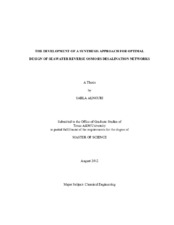| dc.description.abstract | This work introduces a systematic seawater reverse osmosis (SWRO) membrane network synthesis approach, based on the coordinated use of process superstructure representations and global optimization. The approach makes use of superstructure formulations that are capable of extracting a globally optimal design as a performance target, by taking into consideration desired process conditions and constraints that are typically associated with reverse osmosis systems. Thermodynamic insights are employed to develop lean network representations so that any underperforming solutions can be eliminated a priori. This essentially results in considerable improvement of the overall search speed, compared to previously reported attempts. In addition, the approach enables the extraction of structurally different design alternatives. In doing so, distinct membrane network design classes were established by partitioning the search space, based on network size and connectivity. As a result, corresponding lean superstructures were then systematically generated, which capture all structural and operational variants within each design class. The overall purpose is thus to enable the extraction of multiple distinct optimal designs, through global optimization. This mainly helps provide design engineers with a better understanding of the design space and trade-offs between performance and complexity.
The approach is illustrated by means of a numerical example, and the results obtained were compared to previously related work. As anticipated, the proposed approach consistently delivered the globally optimal solutions, as well as alternative efficient design candidates attributed to different design classes, with reduced CPU times.
This work further capitalizes on the developed representation, by accounting for detailed water quality information, within the SWRO desalination network optimization problem. The superstructures were modified to incorporate models that capture the performance of common membrane elements, as predicted by commercially available simulator tools, e.g. ROSA (Dow) and IMSDesign (Hydranautics). These models allow tracing of individual components throughout the system. Design decisions that are supported by superstructure optimization include network size and connectivity, flow rates, pressures, and post treatment requirements. Moreover, a detailed economic assessment capturing all the significant capital and operating costs associated in SWRO processes, including intake, pre and post treatment has also been accounted for. These modifications were then illustrated using a case study involving four seawater qualities, with salinities ranging from 35 to 45 ppt. The results highlight the dependency of optimal designs on the feed water quality involved, as well as on specified permeate requirements. | en |


